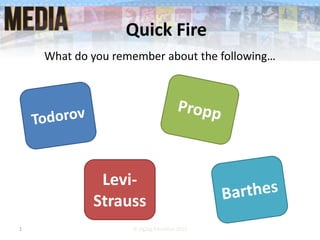More Related Content Similar to Todorov's theory of narrative structure Similar to Todorov's theory of narrative structure (14) More from howardeffinghammedia More from howardeffinghammedia (20) 1. Quick Fire
1 © ZigZag Education 2015
Levi-
Strauss
What do you remember about the following…
2. Todorov
• Todorov studied fairy tales and concluded that all stories followed
the same steps to make their stories
2 © ZigZag Education 2015
Equilibrium •A state of
normality
Disruption
•Something
happens to
disrupt the
normality
Recognition •Hero realises
the disruption
Complications
•Hero meets
issues trying
to restore the
equilibrium
New
Equilibrium
•Hero restores
a new
normality
4. For an answer…
• The advert for …… uses Todorov’s theory by
showing _____________stage
• This can connote_________
04/09/2014 Term 1, Lesson 1 4
5. Propp
• Vladimir Propp studied fairy tales and recognised the same stock characters
in every story
5 © ZigZag Education 2015
HeroCharacter
•Character who seeks something. The Protagonist.
VillainCharacter
•Opposes the heroes quest. The Antagonist.
PrincessCharacter
•The heroes reward – not necessarily a person!
DonorCharacter
•Gives the hero something to help with his quest
DispatcherCharacter
•Sends the hero on his quest
HelperCharacter
•Helps the hero – often a sidekick
False HeroCharacter
•Looks heroic but disrupts the hero in their quest
Princess’ FatherCharacter
•Rewards the hero by giving him the princess
7. For an answer…
• The advert for …… uses Propp’s theory by
showing _____________ characters
• This can connote_________
04/09/2014 Term 1, Lesson 1 7
8. Levi Strauss
• Claimed stories could only exist with BINARY OPPOSITES,
elements that are against each other
8 © ZigZag Education 2015
Binary Opposite Examples
Woman
Beauty
Strength
Decisive
Loud
Old
Rich
Exciting
Men
Ugliness
Weakness
Indecisive
Quiet
Young
Poor
Boring
10. For an answer…
• The advert for …… uses Levi-Strass’ Binary
Opposites theory by showing _____________
against _____________
• This can connote_________
04/09/2014 Term 1, Lesson 1 10
11. Barthes
• Roland Barthes explored how an audience decodes a text and
the different codes used to construct meaning from a text
11 © ZigZag Education 2015
Enigma Code
Anything that sets up a
mystery or question
Action Code
Actions and behaviours that
are universally understood
Symbolic Code
Use of psychological
symbols or binary
opposition (can go
against expectations)
Cultural Code
Codes that are
understood across
the world as culture
13. For an answer…
• The advert for …… uses Barthes’ Codes theory
by showing _____________
• These can connote_________ and ________
which is positive for the brand image
because__________________
04/09/2014 Term 1, Lesson 1 13
14. Other Narrative
Devices
Device Definition
Open
Gives the audience the full storyline so they feel fully engaged –
feeling of respect.
Closed
Gives the audience a partial glimpse of the story and leaves out
details. Engages the audience to “solve” the story.
Dramatic Irony
Gives audience information the people in the advert don’t know –
feeling of empowerment
Cliff-hanger
The story has a dramatic moment which lacks resolution – feeling of
tension and mystery.
Interactive
Advert gets the audience to be included, maybe by making choices –
Feelings of being part of community and special.
14 © ZigZag Education 2015
15. Structure of TV Adverts
Establishing
Problem/Situation
Benefits of
Product
Call to Action
Editor's Notes http://www.tellyads.com/play_advert/?filename=TA8721&advertiser=Twinings&type=recent
http://www.tellyads.com/recent_additions.php
